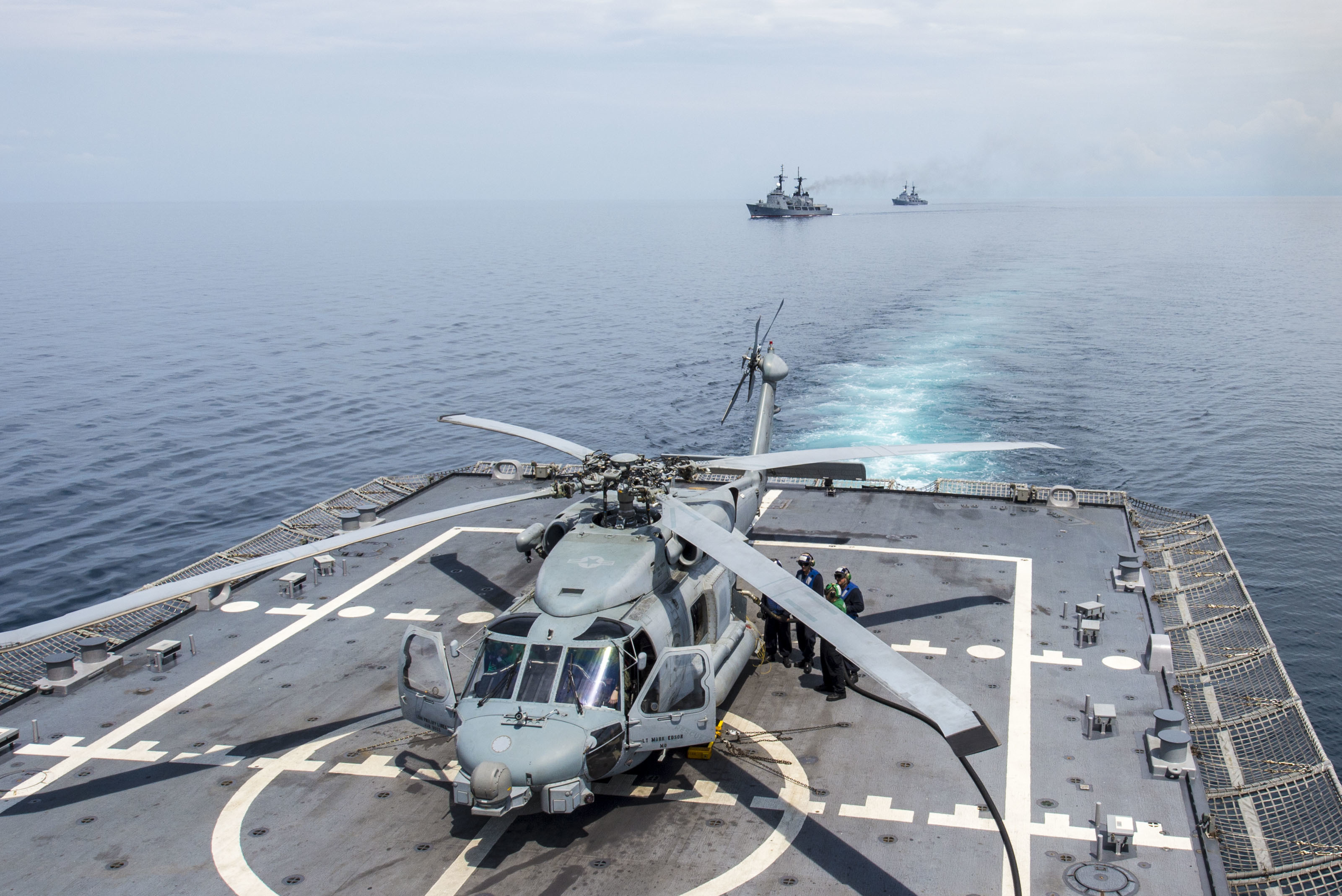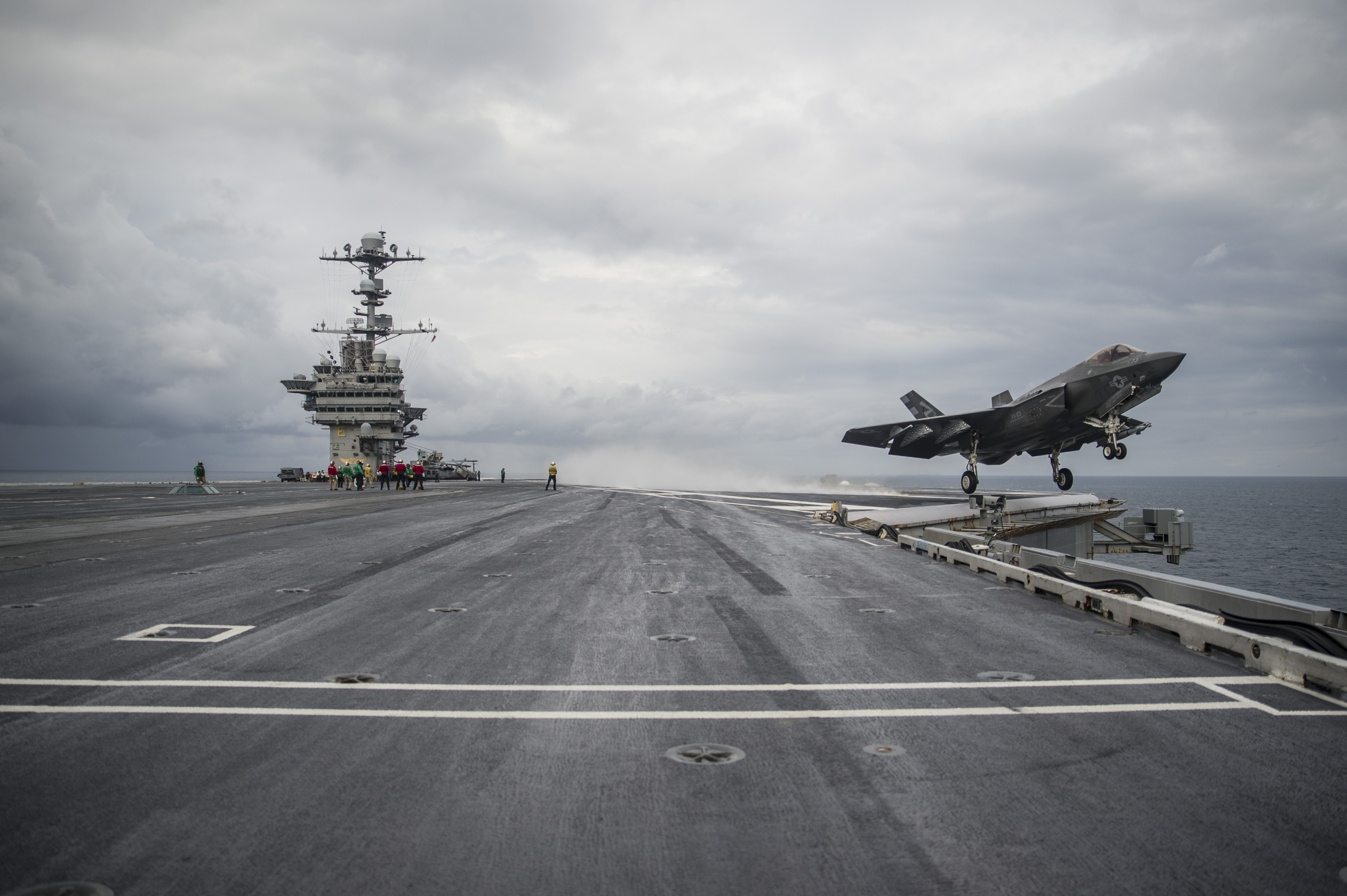
The House Armed Services Committee added to its annual defense bill provisions allowing the military to buy more F-35 Lighting II Joint Strike Fighters if the program could achieve sufficient cost-savings, addressing the health and future of the MH-60R anti-submarine warfare helicopter, encouraging the Navy to continue buying aircraft carriers every three years, and more.
To supplement the Fiscal Year 2019 National Defense Authorization Act language the committee released over the last couple weeks, HASC members added more provisions during a marathon 14-and-a-half-hour markup on Wednesday and Thursday.
Two amendments passed related to the Navy’s MH-60R anti-submarine warfare helo. One notes that a mid-life upgrade effort will be starting in FY 2020 and requests a Navy review ahead of starting that program.
“The committee is encouraged by advances in dipping sonar utilizing low frequency detection and beam-forming technologies, allowing multiple boundary interactions, and interoperability with shipboard sonars and sonobuoys, adding greatly enhanced protection to the carrier battle group. Moreover, these advances in technology are derived from U.S. sources, vice foreign technologies.”
In tandem with the encouraging tech development, though, the amendment notes concern that, “the current MH-60R anti-submarine warfare system – Airborne Low Frequency Sonar (ALFS) –that serves as the primary ASW sensor in the Carrier Strike Group, has a component failure rate that has depleted the spares inventory, impacting deployed and non-deployed readiness, including the ability to support concurrent MH-60R deployments. Therefore, the committee directs the Secretary of the Navy to submit a report to the House Armed Services by March 1, 2019 on the current operability and readiness issues of ALFS system and the potential utilization of existing, advanced U.S. technologies to upgrade the MH-60R fleet’s anti-submarine warfare system.”
A separate amendment would require the Navy to look at the feasibility of swapping out two systems on the MH-60R to reduce weight.

“The committee notes the MH-60R is fitted with advanced mission systems and sensors that are capable of detecting and engaging modern submarines in littoral and open ocean scenarios. However, the committee understands that the current ASW sonobuoy receiver is heavy and limited to its specific mission of receiving and transmitting data to and from U.S. Navy sonobuoy fields for analysis through acoustic processors. The committee is aware that new Size Weight and Power (SWaP) receiver technology currently being used on the DDG-51 that could provide the Navy with enhanced capability while also reducing weight on the MH-60R by over forty pounds. Additionally, the committee understands that the new receiver has the capability to integrate a Next Generation Health Monitoring System (NGHMS) which has the potential to replace the current HUMS system on the aircraft, saving an additional fifty pounds of critical weight. The committee is also aware the U.S Army is currently conducting demonstrations of NGHMS on the UH-72 Lakota light utility helicopter.”
The amendment would require the Navy to brief the committee by the end of September on plans to integrate the SWaP receiver and health monitoring system, as well as notional plans to test and buy the equipment.
The bill language that was already released would allow the Navy to procure its next aircraft carrier, CVN-81, two years earlier so as to create a three-year gap between it and CVN-80 and allow the opportunity for savings in a two-carrier buy. An amendment passed in the markup would go one step further, adding that it is the sense of Congress that the Navy sustain the three-year acquisition rate for aircraft carriers.
In another amendment, the committee would allow the Pentagon to “procure a quantity of F-35 aircraft in excess of the quantity authorized by this Act if such additional procurement does not require additional funds to be authorized to be appropriated because of production efficiencies or other cost reductions.” This “buy-to-budget” strategy basically allows the Pentagon to buy as many planes as it can afford for the dollar amount allotted, encouraging the Defense Department and builder Lockheed Martin to find any additional efficiencies they can to bring down per-unit costs.
Also on carrier aviation, an amendment requests a briefing on the carrier air wing’s ability to conduct stealthy long-range strike and whether the Navy can enhance to F-35C to conduct this mission or whether a purpose-built platform like the canceled A-12 would be needed.
“The committee notes that the aircraft carrier air wing has been optimized for striking power and sortie generation and believes that it may not be configured to support the long-range strike required by current and future threat systems. While the introduction of the F-35C will significantly expand stealth capabilities, the F-35C could require increased range to address necessary targets. The committee believes that several options could be used to address this issue to include developing a stealth tanker capability, improved engine technology or to develop and procure a strike capability that is purposely built to strike at increased range. The committee further notes that the Navy previously desired to significantly increase the carrier air wing range with the development of the A-12 aircraft. The committee understands that the A-12 would have included a 5,000-pound internal carriage payload, stealth, and a range of 800 nautical miles. While the committee believes that requirements to support this capability remain relevant and the technology available, the development of the A-12 aircraft was mired in acquisition challenges that eventually resulted in the cancellation of the program. While the committee further believes that the Department of Defense has successfully developed a suite of long-range intelligence, surveillance and reconnaissance capabilities, the committee also believes that it is vital that the Navy develop a carrier-based long-range strike capability. Therefore, the committee directs the Secretary of the Navy to provide a briefing to the Senate Committee on Armed Services and the House Committee on Armed Services by January 25, 2019, on options to expand the strike range of a carrier air wing in a contested environment, including manned and unmanned capabilities, and, Department of the Navy capabilities it plans to pursue in the Next Generation Air Dominance capability,” according to the amendment.

An amendment would also allow the Navy to transfer excess vessels to the Japan Maritime Self-Defense Force, including ships from the decommissioned Tarawa-class amphibious assault ship, Austin-class amphibious transport dock, and Charleston-class amphibious cargo ship.
Another notes a backlog the Navy has in installing complex command and controls systems onto ships and questions whether spending more money could speed up the installations and buy down the backlog of work.
“The Committee remains concerned that the Navy is using lowest price technically acceptable (LPTA) contracting procedures inappropriately, particularly when acquiring complex systems, including command and control systems or services for the installation of command and control systems on ships. The Committee notes that the Navy faces a significant backlog of maintenance and repair on ships and this backlog includes upgrades of command and control systems. The capacity of the Navy to reduce the backlog of needed repairs remains of concern to the Committee. Consequently, the Committee directs the Secretary of the Navy to provide a briefing to the House Armed Services Committee not later than March 1, 2019 on the Navy’s acquisition plan for command and control systems and the installation of these systems aboard Navy vessels. The briefing shall include an overview on how the Navy plans to reduce the backlog of needed command and control system upgrades, as well as the physical installation of these systems on Navy vessels. The briefing shall include the Navy’s plan for acquiring adequate contracting capacity for the performance of the required work, the plan for incentivizing contractors to perform the work quickly, and the total amount of work programmed for the next five years by class of ship.”





